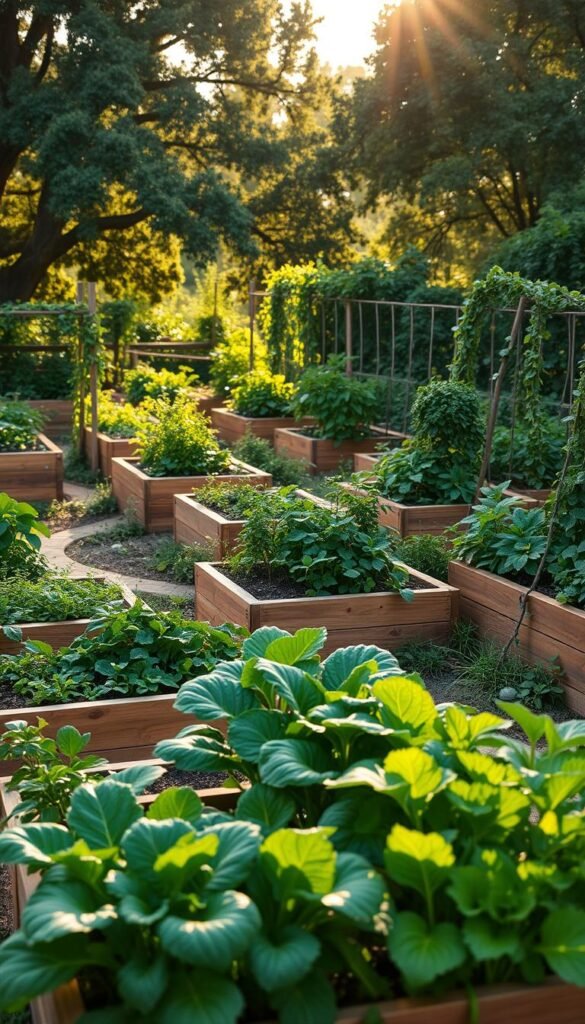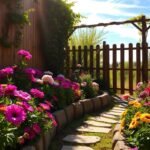Imagine stepping into your backyard and seeing a lush, organized planting area that grows fresh food while looking like a work of art. That’s the magic of blending smart planning with visual appeal. Whether you’re a seasoned grower or just starting out, your outdoor space can become both productive and inviting.
Good planning isn’t just about where to place your planting areas. It’s about making every inch serve a purpose. Think about how pathways can guide the eye, or how tall plants might add depth to your setup. Even the materials you choose for edges or supports can turn simple beds into eye-catching features.
You’ll find that smart choices here do more than save time—they create a place you’ll want to enjoy daily. From optimizing sunlight exposure to adding vertical elements for herbs, every detail matters. The right balance helps your plants thrive while giving your yard a polished, intentional look.
Ready to transform how you grow? Let’s explore how to build a space that feeds your family and sparks joy every time you step outside.
The Value of a Raised Vegetable Garden
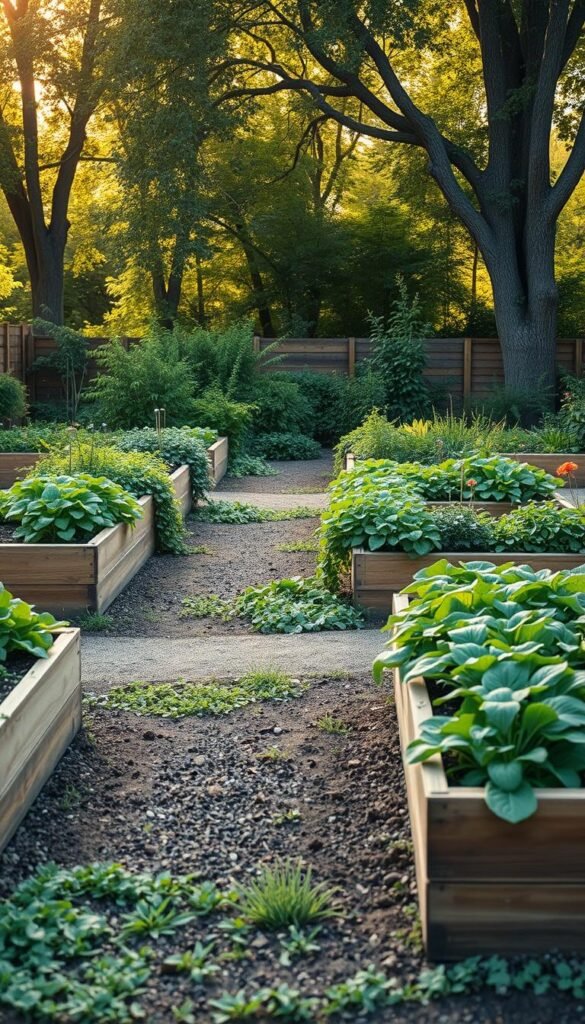
Structured planting areas offer more than neat rows of crops—they create opportunities for healthier habits and better harvests. Many growers report dramatic changes after transitioning from ground-level plots. As one longtime enthusiast shared:
“My Mother’s Day gift of elevated plots gave me back the joy of tending plants without the aches.”
Health, Accessibility, and Increased Yield
Elevated plots reduce physical strain by keeping soil at waist level. You’ll spend less time bending and more time enjoying your space. Better drainage prevents waterlogged roots, while customized soil mixes give plants ideal nutrition.
| Feature | In-Ground | Elevated Beds |
|---|---|---|
| Accessibility | Limited | Easy reach |
| Weed Control | High effort | Low maintenance |
| Yield per Sq Ft | Standard | Up to 4x higher |
| Soil Quality | Variable | Fully controlled |
Ergonomic Benefits and Reduced Back Strain
The right height matters. Waist-level setups let you work standing up, protecting joints and muscles. This design extends your growing years by making the hobby sustainable. You’ll harvest tomatoes without kneeling and trim herbs without crouching.
Structured spaces also simplify pest management. Contained soil deters invasive weeds, while defined borders help organize companion planting. You gain control over your microclimate—a key factor for consistent results.
Getting Started with Your Garden Planning
Mapping your yard’s potential is the first step toward a productive and beautiful setup. Start by walking your property with fresh eyes—note how sunlight dances across different areas and where shadows linger. This groundwork helps you match plants to their ideal conditions while avoiding costly mistakes.
Assessing Your Yard and Available Space
Grab a tape measure and sketchpad. Record exact dimensions, slopes, and obstacles like tree roots or utility lines. Pay attention to wind patterns—a breezy corner might need protective screens for delicate greens. Soil quality matters too: test drainage by watering a small patch and timing how long it takes to absorb.
Selecting the Ideal Location for Growth
Most edibles crave 6-8 hours of daily sun. Track light patterns every 2 hours to pinpoint the brightest zones. Prioritize spots near water sources—dragging hoses gets old fast. If your space allows, position growing space close to the kitchen. You’ll snip herbs more often when they’re just steps away.
Leave room to expand. Even a modest setup might inspire adding berry bushes or flower borders later. Smart planning today means fewer headaches tomorrow—and a yard that grows alongside your skills.
Raised Vegetable Garden Design Layout: Combining Aesthetic and Function
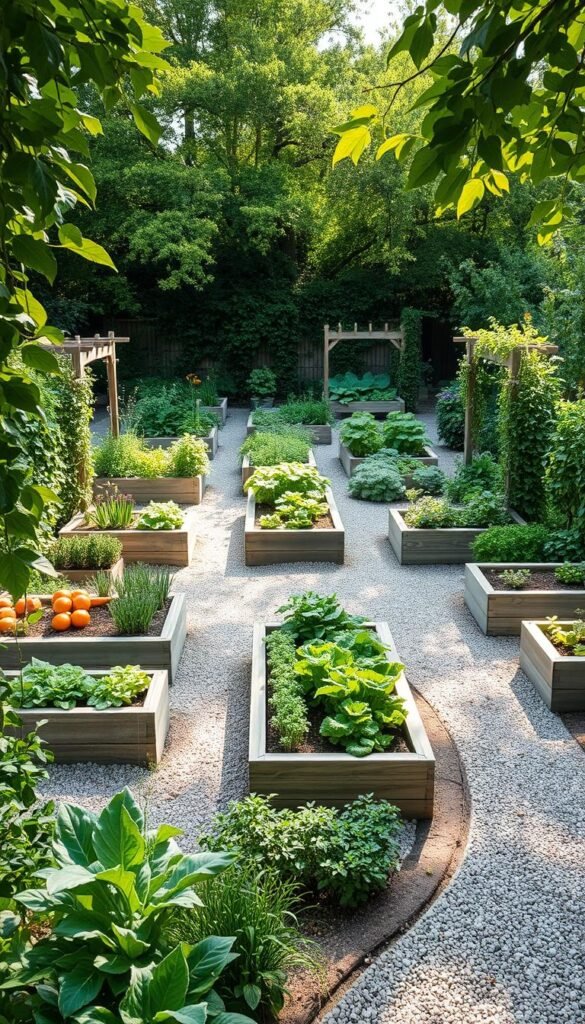
Think of your outdoor area as a blank canvas where practicality meets creativity. Five foundational patterns serve as your building blocks, letting you craft arrangements that match your vision. Like puzzle pieces, these templates adapt to small patios or sprawling yards while keeping beauty and productivity balanced.
Mixing formats unlocks surprising potential. Pair a compact trio of beds with symmetrical potager lines, or frame twin plots with curved borders. One grower shared:
“After adding an L-shaped edge to my setup, I started lingering outside just to admire the shapes.”
| Layout Type | Best Use | Key Features |
|---|---|---|
| Garden Trio | Small spaces | Three compact beds, rotational planting |
| Formal Potager | Visual impact | Geometric patterns, mixed crops |
| L-shaped Border | Edge utilization | Maximizes corners, creates flow |
| Twin Garden | Companion planting | Paired beds, easy crop rotation |
| Vertical Stack | Limited ground area | Tiered planters, climbing supports |
Your space becomes more inviting when layouts spark joy. Curved pathways between angular beds soften the look, while repeating colors in flowering herbs tie the scene together. You’ll naturally gravitate toward areas that feel intentional.
Well-planned arrangements do double duty. They simplify maintenance through clear zones for watering or harvesting. More importantly, they transform chores into moments of pride—because when your setup looks good, every task feels rewarding.
Exploring Diverse Garden Bed Materials and Styles
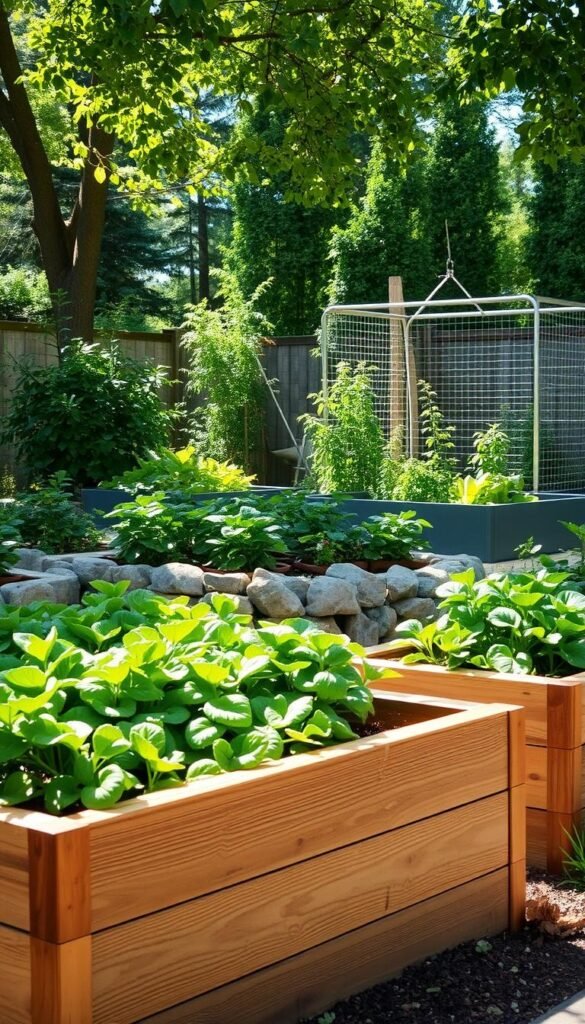
Your planting space becomes an extension of your home’s personality through material choices. Let’s break down how different options balance practicality with visual harmony.
Corten Steel, Stone, and Wood: A Comparative Look
Corten steel stands out for its modern edge. The rust-colored patina develops naturally, creating striking contrast against greenery. It resists warping and lasts decades with minimal upkeep—perfect for sleek, urban spaces.
Natural stone brings timeless elegance. While pricier upfront, its rugged durability handles harsh weather effortlessly. Stacked limestone or granite blends seamlessly with cottage-style yards or minimalist landscapes.
Wood remains a crowd favorite for its warmth. Cedar and redwood resist rot naturally, though you’ll need to reseal them every few years. One gardener noted:
“My cedar beds aged gracefully—silver-gray tones now complement my rustic fence.”
| Material | Lifespan | Maintenance | Cost |
|---|---|---|---|
| Corten Steel | 25+ years | None | $$$ |
| Stone | Lifetime | Low | $$$$ |
| Wood | 5-15 years | Annual | $$ |
Match materials to your home’s exterior for curb appeal. Metal planters mirror modern fixtures, while reclaimed bricks echo traditional pathways. Your beds become design elements that elevate the entire property.
Innovative Raised Bed Configurations to Maximize Your Growing Space
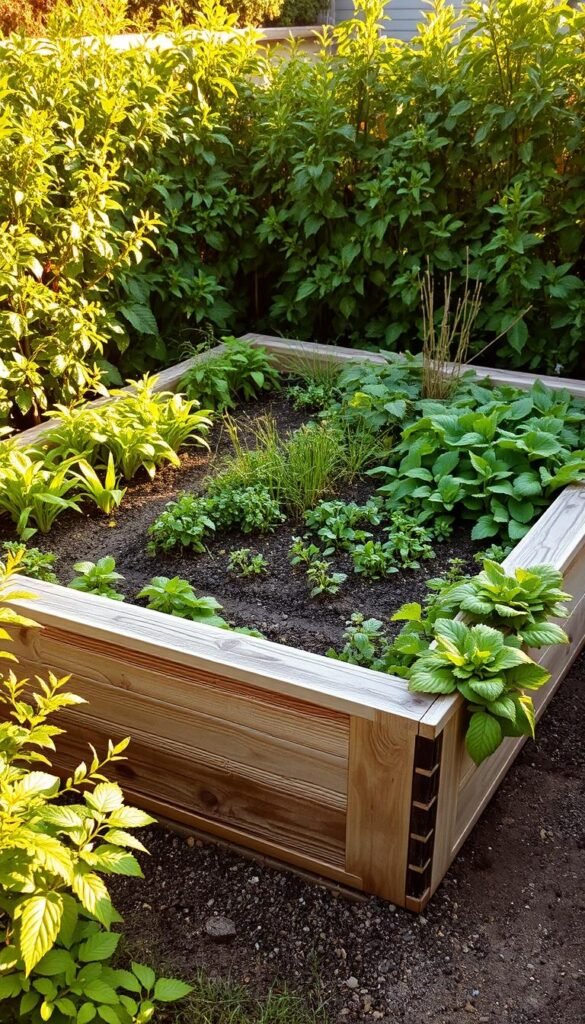
Your outdoor space holds hidden potential when you rethink traditional planting arrangements. Clever configurations turn awkward corners and narrow strips into thriving zones while adding visual rhythm to your landscape.
L-Shaped Raised Beds and Twin Garden Options
L-shaped raised beds transform underused areas into productive spaces. Wrap them around patios, hug existing trees, or frame seating areas. This shape creates natural pathways while offering 30% more planting room than standard rectangles.
Twin setups bring balance through mirrored plots. Separate cool-season greens from heat-loving tomatoes, or pair flowers with herbs to deter pests. One gardener shared:
“My twin beds let me rotate crops effortlessly while keeping my kitchen stocked year-round.”
Kitchen Garden Design and Border Garden Ideas
Position your kitchen garden design within arm’s reach of cooking spaces. Cluster basil, parsley, and cherry tomatoes near pathways for quick snips. For fresh inspiration, explore these creative raised bed configurations that blend practicality with style.
Border gardens turn functional edges into showstoppers. Line walkways with dwarf fruit bushes or frame fences with cascading beans. These narrow plots:
- Use vertical space with trellises
- Softens hardscapes with greenery
- Creates natural dividers between zones
Whether you choose angular L-shapes or flowing borders, smart layouts make every square foot count. Your space becomes both abundant and inviting—proof that creativity grows the best harvests.
Designing Ergonomic Raised Garden Beds for Comfort
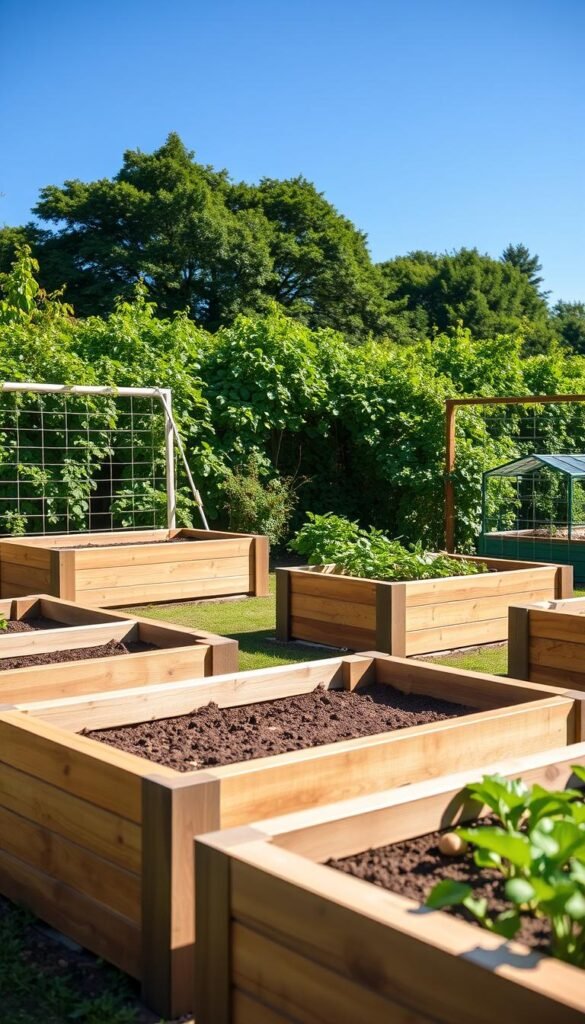
Gardening shouldn’t leave you sore. By adjusting your setup to work with your body, you create a sustainable routine that keeps you growing year after year. Let’s explore how thoughtful engineering can turn strenuous tasks into effortless moments.
Why Height Makes All the Difference
Waist-height beds let you tend plants without bending. Imagine sowing seeds or picking peppers while standing upright—no more kneeling on hard ground. For most people, 30-34 inches tall works best, but measure from your wrist to the floor while standing for a personalized fit.
Deep-rooted crops need deeper soil. Carrots and parsnips thrive in 18-inch beds, while leafy greens flourish in shallow 8-inch setups. Match your bed depth to your favorite plants for healthier roots and bigger harvests.
| Plant Type | Ideal Depth | Recommended Height |
|---|---|---|
| Root Vegetables | 12-18″ | 24-30″ |
| Leafy Greens | 6-8″ | 30-36″ |
| Herbs | 8-12″ | 34-36″ |
One urban gardener shared:
“Since switching to elevated beds, I’ve doubled my growing time without backaches. Now I actually look forward to weeding!”
These adjustments help everyone enjoy fresh produce longer. Whether you’re managing arthritis or just want efficiency, proper ergonomics make maintenance easier. Pair your setup with smart space optimization techniques to boost yields while keeping tasks comfortable.
Your garden beds become partners in wellness when designed for ease. You’ll spend less time recovering and more time savoring the fruits of your labor—literally.
Incorporating Trellises and Vertical Elements Effectively
Elevate your growing space—literally—by adding vertical elements that do double duty. Trellises transform empty air into productive real estate while creating eye-catching focal points. These structures help your plants climb toward sunlight instead of sprawling across precious ground area.
Matching Support to Your Greens
Choose materials that suit your plants’ needs and your yard’s vibe. Lightweight wire grids work for delicate peas, while sturdy wooden frames handle heavier melon vines. Metal arch trellises make stunning entryways when covered in flowering climbers.
Teepee-shaped supports offer playful functionality. Kids love hiding under bean-covered trellises in summer. These triangular frames also create natural privacy screens between beds or seating areas. One parent shared:
“Our cucumber teepee became the kids’ favorite snack spot—they’d graze while playing hide-and-seek.”
Smart vertical choices boost harvests and beauty. Train pole beans up a sunny arch near your patio, or let fragrant jasmine climb a decorative screen. Your garden gains depth and dimension when greenery reaches for the sky.

